Class SoVolumeRender
- java.lang.Object
-
- All Implemented Interfaces:
SafeDisposable
public class SoVolumeRender extends SoVolumeShape
Renders data volumes using direct volume rendering. This node renders volume data using "direct volume rendering". The volume process involves sampling, interpolation, classification and composition. By default the rendering algorithm is a GPU-based technique called raycasting. Raycasting has similarities to the well known algorithm called raytracing, but is specialized for volume data (renders voxels not triangles) and does not currently implement reflection or refraction. One or more "rays" are cast through the volume from each relevant pixel on the screen. Samples are taken at intervals along each ray. The sample interval is controlled by thenumSlicesandnumSlicesControlfields At each sample point a value is interpolated from the closest voxels. The interpolation technique is controlled by theinterpolationfield. Classification means that color and opacity are computed based on the currentSoDataRangeandSoTransferFunction(and possibly values from other volumes - seeSoVolumeShader). Optional rendering effects may modify the base color and/or opacity. These effects are controlled by anSoVolumeRenderingQualitynode and include lighting, shadows, edge coloring, boundary opacity and more. The sample is then composited with other samples along the ray. Composition is controlled by therenderModefield. By default colors are combined based on the opacity of the sample (alpha blending). The ray is terminated if it reaches full opacity or reaches the current depth in the depth buffer.For a volume containing scalar data values, each voxel's basic RGBA value is determined by the current
SoDataRangeandSoTransferFunctionnodes. This value is combined with current diffuse color and transparency (set, for example, with anSoMaterialnode). This means that, for example, the current transparency can be used as a global alpha scale factor to decrease the opacity of all voxels. By default, scalar values are loaded on the GPU and the GPU interpolates between the data values before applying the color map. See theinterpolationfield for options. To force RGBA values to be loaded (implies color map is applied on the CPU and GPU interpolates between color values), see the usePalettedTexture field in theSoVolumeDatanode.For an RGBA volume, each voxel's base RGBA value comes directly from the volume data (
SoDataRangeandSoTransferFunctionare ignored). However if lighting is enabled, the final voxel color is also affected by the emissiveColor, specularColor and shininess fields ofSoMaterial.The
samplingAlignmentfield controls whether the samples are axis aligned (perpendicular to one axis of the volume), view aligned (perpendicular to the view direction) or boundary aligned (each ray starts at the first intersected voxel with alpha value > 0). Generally boundary aligned slices should be used (better image quality). UsingSoVolumeGroup, SoVolumeIsoSurface orSoProjectionnodes will automatically switch to view-aligned samples.The property nodes SoVolumeIsoSurface and
SoVolumeDataDrawStyleadd additional rendering styles and can be used, for example, to forceSoVolumeRenderto draw a GPU computed isosurface instead of volume rendering.Example rendering:
lighting = false lighting = true 

composition = ALPHA_BLENDING composition = MAX_INTENSITY 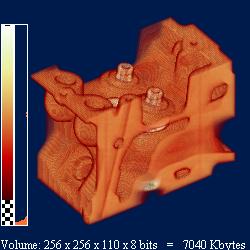
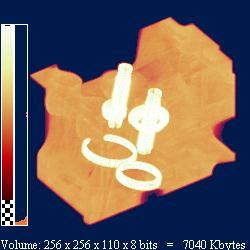
Multiple volumes:
VolumeViz provides several mechanisms for combining or rendering multiple volumes, depending on the application's specific requirements. There are several cases:
- CPU data combining
The data values from multiple volumes can be combined on the CPU during data loading, using theSoDataCompositornode. For example computing the "difference" between two volumes on the fly.SoLDMDataTransformandSoVolumeTransformcan be used to modify data for a single volume, for example scaling data values or computing a derived data set.SoLDMDataTransformis applied when data is loaded andSoVolumeTransformis applied before data is transferred to the GPU. - Multiple data sets
These are volumes that are really multiple data sets on the same "grid", in other words volumes having exactly the same dimensions and extent. For example, seismic attribute volumes. These volumes can be combined on the GPU using a simple fragment shader function. For example, replacing the VVizComputeFragmentColor (GLSL) function allows "co-blending" the colors from multiple volumes. SeeSoVolumeShaderfor more details. Use anSoMultiDataSeparatornode to group the volume data nodes that should be combined. Multiple independent volumes
These are volumes in the same scene that are completely independent (but might overlap in space) or have different dimensions or different extents. For example, medical datasets from different modalities.
In order to ensure that the rendering of overlapping transparent volumes is properly interleaved, there are 2 options:
- if each volume needs their own rendering parameters and shading options, then use an
SoVolumeGroupnode to group the volume data nodes and rendering nodes, with anSoVolumeRendernode for each volume. - if the same rendering parameters and shading options can be applied to all volumes, then use an
SoMultiDataSeparatornode to group the volume data nodes and a singleSoVolumeRendernode.
This option should be preferred as it does not suffer the limitations ofSoVolumeGroup.
However, note thatSoVolumeRenderingQuality.voxelizedRenderingis not supported by this feature.
- if each volume needs their own rendering parameters and shading options, then use an
Custom shaders:
The
SoVolumeShadernode allows a variety of custom shader functions to be defined for special computation or rendering effects on single volumes or multiple volumes. All of these features require programmable shader support on the GPU. Be sure to use anSoMultiDataSeparator(instead ofSoSeparator) when combining multiple volumes.Composition of multiple independent volumes:
It is possible to compose datasets that have different dimensions, tile sizes and transformations. In those cases, the volume rendering will be applied on the union of the extents of all the
SoVolumeDatanodes on state.
In addition, texture coordinates conversion functions are provided in the VolumeViz/vvizStructure.h shader include in order to help fetch the correct data values in custom shaders.
For instance,
can be used to convert texture coordinates related to one dataset to texture coordinates related to another dataset.vec3 VVizTextureToTextureVec(in VVizDataSetId datasetSrc, in VVizDataSetId datasetDst, in vec3 texCoord);
The conversion is based solely on the transformations applied to each dataset, which are defined by their model matrix and their extent.
Please note that the model matrix of a dataset is defined by to theSoTransformationnodes that are placed before theSoDataSetnode in the order of the traversal.See
SoVolumeShader.FRAGMENT_COMPUTE_COLORfor an example of a shader implementing the VVizComputeFragmentColor() function in that case.Lighting:
The
SoVolumeRenderingQualityproperty node allows you to to enable GPU computed lighting based on the firstSoLightnode in the scene graph. (Note that this is typically the viewer's "headlight".) VolumeViz supports two lighting algorithms. They are both computed on the GPU and are independent (but normally only one should be enabled).- Gradient lighting
Computes the effect of lighting for every sample along the ray, similar to the computation for polygonal geometry, but using a gradient vector computed from the voxel data values instead of a normal vector. Gradient lighting is enabled by theSoVolumeRenderingQualitylighting field. Gradient lighting is the classic solution but can have problems in relatively homogeneous regions where the gradient magnitude is small and gradient direction somewhat random. Multiple fields affect this computation including interpolation, gradientThreshold, gradientQuality and surfaceScalarExponent. - Deferred lighting
Computes the effect of lighting for every visible voxel, as a post-processing step, using a gradient vector computed from the (visible) voxel depth values. Deferred lighting is enabled by theSoVolumeRenderingQualitydeferredLighting field. Deferred lighting generally provides better performance because fewer lighting computations are needed. Deferred lighting generally provides better image quality for volumes that inherently contain surfaces (sharp gradients) like medical and industrial scans. Deferred lighting is most effective when the opacity values in the transfer function are approximately binary (mostly 0 and 1 values). See also theopacityThresholdfield.
Warning: CPU computed lighting can be enabled using the
lightingfield in this node. In this case thelightDirectionandlightIntensityfields control the light. Note that when lighting is computed on the CPU, RGBA textures are loaded on the GPU, so color map changes generally require re-loading all the data textures. NOTE: This feature is obsolete. UseSoVolumeRenderingQuality.lightinginstead.Gradient lighting Deferred lighting 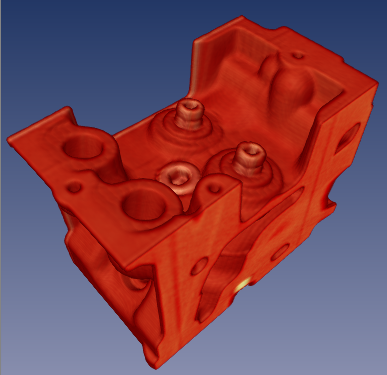
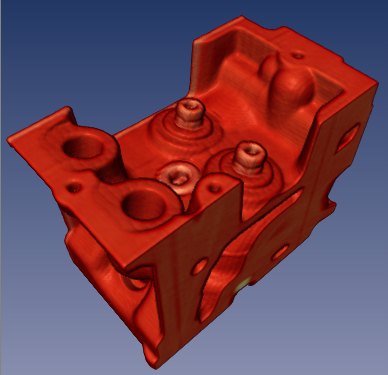
Open Inventor shadow rendering works for volume rendering similar to any other geometry. When shadow rendering is enabled (see
SoShadowGroup), non-transparent voxels can cast and receive shadows (seeSoShadowStyle). Shadow rendering is independent of whether lighting is enabled for the volume.SoVolumeRenderalso supports "ambient occlusion" rendering (see ambientOcclusion field inSoVolumeRenderingQuality). This rendering mode is visually a kind of self-shadowing and represents an approximation of the effect of ambient global lighting in the scene. Ambient occlusion can be combined with gradient or deferred lighting and with shadow casting.Shadow casting Ambient occlusion 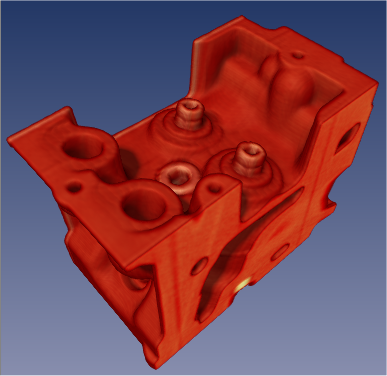

VolumeViz provides multiple tools for clipping volume rendering. Any or all of these tools may be combined for more complex clipping situations. Note that these tools clip all volume shapes including slices.
- The
SoROI(Region of Interest) node limits volume rendering to a subvolume. TheSoROInode's EXCLUSION_BOX mode can also be used to exclude a sub-region, forming what is sometimes called a "chair cut". Note that the Region of Interest also limits data loading , so it is valuable when the total size of the volume exceeds the available system memory. - The
SoVolumeClippingGroupnode clips volume rendering to any closed shape defined by a group of standard Open Inventor geometry nodes. Both "inside" and "outside" clipping are supported. TheSoScreenDrawer,SbExtrusionGeneratorandSoCSGShapenodes are useful for creating clipping geometry for interactive volume "sculpting". - The
SoUniformGridClippingandSoUniformGridProjectionClippingnodes clip volume rendering against one or more surfaces defined by a height field. This is particularly useful in seismic applications for clipping against (or between) horizon surfaces. - The
SoVolumeMasknode can be used to clip volume rendering against a boolean mask volume on a per-voxel basis. But the mask mechanism is much more powerful than that. Each region can have its own transfer function (color map) usingSoTransferFunctionnodes. Each region can also have its own draw style (volume rendering, isosurface or boundary) usingSoVolumeDataDrawStylenodes. Each region, including the original unmasked volume, is only visible if there exists a transfer function (SoTransferFunction) with the same id value.
Picking:
SoRayPickActionhandles picking of VolumeViz shapes similar to other geometry in the scene, but with additional features. Picking on anSoVolumeRendernode can return the first non-transparent voxel "hit" or the entire set of intersected voxels along the pick ray, depending on the pickAll flag of theSoRayPickAction. Similar to other geometry,SoPickedPointcan return a "detail" class specific toSoVolumeRender.SoVolumeRenderDetailreturns the IJK (voxel coordinate) position of the pick and the data value at that point.Since Open Inventor 8.6, the
SoVolumeRendernode (by default) uses the GPU to compute the picked voxel during anSoRayPickAction. For this to work, theSoRayPickActionmust have its scene manager initialised using the methodSoAction.setSceneManager().SoHandleEventActiondoes this automatically, so it is not necessary for the application to take any action when using (for example) anSoEventCallbacknode and calling the getPickedPoint() method. However if the application creates its ownSoRayPickActionthen it should set the scene manager. If no scene manager is specified, a warning message is issued and software picking is done. If necessary, using the GPU for volume picking may be disabled by setting the environment variable IVVR_GPU_PICKING to 0 (seeSoPreferences).Projection:
The
SoVolumeRendernode supports projected volume rendering, for example rendering a volume defined on a grid of latitude / longitude coordinates. Projection is enabled by adding anSoProjectionnode before theSoVolumeRendernode (seeSoProjectionfor more information about supported coordinate systems, ellipsoids and map projections). The projection quality versus speed ratio can be controlled using the newprojectedTileSubdivisionfield that defines how often each tile's geometry will be subdivided when projected. This is important because only the corner points of the tiles are projected, not the individual voxels. So subdividing the tiles provides a better approximation of the actual shape of the grid. Volume projection works with both regular (uniform voxel spacing) and rectilinear (non-uniform voxel spacing) grids.SoProjectionautomatically selects view-aligned sampling.Warning:
- Volume projection is incompatible with some options enabled by the VolumeRenderingQuality node.
Do not enable the preIntegrated, jittering or edgeDetect2D fields. - Volume projection requires all culling to be disabled.
The following options in classSoLDMGlobalResourceParametersshould be disabled: setScreenResolutionCulling (default is false), setViewpointRefinement (default is true) and setViewCulling (default is true).
Performance:
Volume rendering performance is affected by many factors including the size of the volume and the rendering options selected. Image quality is also affected by many rendering options and, in general, higher quality implies lower performance. Some of the factors affecting volume rendering performance are:
- Number of voxels:
This mainly depends on the size of the volume, but can be reduced using anSoROI(region of interest) node. - Number of pixels:
A larger number of pixels means a larger number of rays must be cast through the volume and therefore the shader execution time on the GPU will be longer. This effect is most noticeable when high quality rendering options are enabled. The number of pixels rendered can be temporarily reduced by setting thelowResModefield to DECREASE_SCREEN_RESOLUTION. This reduces the number of times the shader programs running on the GPU must be executed. - Number of samples (slices):
This is controlled by thenumSlicesandnumSlicesControlfields. Note that better image quality can obtained with the same number of samples by enabling options like preintegrated rendering (seeSoVolumeRenderingQuality) and/or the BOUNDARY_ALIGNED setting forsamplingAlignment. The number of samples can be automatically decreased when interacting using anSoInteractiveComplexitynode.
Since Open Inventor 9.2, we recommend to set thenumSlicesControlfield to AUTOMATIC and thenumSlicesfield to -1. The number of samples will be computed based on the dimensions of the volume (number of voxels on each axis), theSoComplexity.valuesetting and the viewing direction. If the viewing direction changes, the number of samples will be automatically adjusted. - Opacity:
Increasing the number of opaque, or nearly opaque, voxels in the volume (usingSoTransferFunction) will generally improve performance because the sampling rays can terminate sooner. See also IVVR_ALPHA_THRESHOLD_INTERACTIVE inSoPreferences.
If you are using a completely opaque transfer function, for example with a "volume probe",SoVolumeSkinwill generate the same image much faster. - Rendering options:
Many of the advanced rendering options and rendering effects enabled bySoVolumeRenderingQualityhave an additional performance cost. These include lighting, edge coloring, boundary opacity, cubic interpolation and gradient quality. These settings can be automatically changed while interacting using anSoInteractiveComplexitynode. - Tile size:
For backward compatibility, the default tile size is still only 64. This is quite small for modern CPU/GPU hardware. The smaller the tile size, the larger the total number of tiles that must be managed by VolumeViz. This overhead can be significant, especially for operations that require reloading the data textures on the GPU, for example, changing the data range (SoDataRange). For smaller volumes, like 512^3, it can be efficient to set the tile size large enough to contain the entire volume. For very large volumes, larger tile sizes are efficient forSoVolumeRenderbut somewhat inefficient for slice rendering because complete tiles must be loaded even though the slice only uses part of the data (see alsoSoSlice.largeSliceSupport). Applications should experiment.
For volumes stored in LDM file format, the tile size must be specified when the volume is converted to LDM (seeSoConverterand the "-t" option). For other data data formats the tile size can be specified using theSoVolumeDatanode's ldmResourceParameters field, but only after setting the filename field or calling the setReader() method. - LDM_USE_IN_MEM_COMPRESSION
This environment variable (seeSoPreferences) affects much more than its name implies. VolumeViz always manages data as "tiles", regardless of the data format. In many cases VolumeViz must create (or uncompress) the tiles at run time. These cases include in-memory volumes, any volume reader that does not implement the readTile() method (all built-in formats except LDM) and compressed LDM format files. If this variable is true ( the default value), then VolumeViz only keeps a small cache of tiles in memory. See theSoBufferObjectmethod getBufferObjectCache() for the current default and note that this setting is separate from the max main memory parameter. If a tile's data is needed and that tile is not in the cache, the tile must be recreated. This overhead can be significant, especially for operations that require recreating data textures on the GPU, for example, changing the data range (SoDataRange). We recommend setting this variable to false unless the memory conserving feature for compressed tiles is critical.VolumeViz keeps tiles from a compressed LDM format file in CPU memory as compressed data. This option allows more tiles to be kept in the same amount of CPU memory, but incurs a performance penalty because a tile must be uncompressed when its data is needed, unless it is found in a small cache of uncompressed tiles (see
SoBufferObject.getBufferObjectCache). This penalty is particularly noticeable for operations that require recreating data textures on the GPU, for example changing the data range (SoDataRange).
If rendering performance is too slow, it may be necessary to render with high quality settings when the user is not interacting with the scene, but temporarily switch to high performance (lower quality) settings when the user is interacting. Open Inventor automatically sets "interactive mode" when the user is moving the camera or moving a dragger. The application can explicitly set interactive mode, for example while the user is moving a slider in the user interface. Some important tools are:
- LowResMode
For example, set thelowResModefield to DECREASE_SCREEN_RESOLUTION and set thelowScreenResolutionScalefield to 2 or 4. In interactive mode VolumeViz will render the volume at lower resolution (reducing the number of sample rays and shader executions). SoInteractiveComplexity
This node allows you to specify different values to use for certain fields in interactive mode. For example set a smaller value forSoComplexity.value(reduces the number of samples) or turn off an expensive rendering option. The values specified inSoInteractiveComplexityoverride the actual fields in the scene graph.
Limitations:
- Multi-thread rendering:
Unlike most Open Inventor nodes, VolumeViz nodes do not support simultaneous rendering in multiple threads (even when Open Inventor is initialized using one of the initThread() methods). - Geometric transforms:
The volume size (extent in 3D space) and orientation can be modified by transformation nodes in the scene graph just like any geometry. For a volume this in turn modifies the appearance of volume rendering nodes likeSoVolumeRender. However please note: The same transformation must be applied to the volume data node and all volume rendering nodes associated with that volume. So effectively any transformation nodes that affect the volume must be placed before the volume data node. - Multiple dataset :
The fielddataSetIdshas limitations described here - Render modes:
When using one of the projection render mode (i.e. MIN_INTENSITY_PROJECTION, MAX_INTENSITY_PROJECTION, SUM_INTENSITY_PROJECTION or AVERAGE_INTENSITY_PROJECTION):- Only raycasting mode is supported
- No depth information is retained.
SoVolumeRenderingQuality.preIntegratedis not taken into account.
EXAMPLE For simple data sets, a basic VolumeViz rendering could be achieved with only a few nodes: minimally an
SoVolumeDatanode to identify the data set and one rendering node. However most data sets need at least some of the additional nodes shown here in order to get a correct and useful rendering. Most applications will need additional nodes to take advantage of region of interest, interaction, clipping and other VolumeViz features. Please consider the code shown here as simply a guideline and a starting point for exploring the many powerful features available in Open Inventor.Note that some of the property nodes (data, material, color map, etc) will typically be shared by multiple rendering nodes. For example the volume data usually only needs to be loaded once, using a single
SoVolumeDatanode. Multiple slices and/or regions can be rendered using that data node and they may use the same transfer function or each have their own.Also note that this example is for a data volume, not a label volume. Please see the notes about label volumes following the code block.
// Default setting can be a performance bottleneck SoPreferences.setValue( "LDM_USE_IN_MEM_COMPRESSION", "0" ); // Default setting can be a performance bottleneck SoPreferences.setValue( "LDM_USE_IN_MEM_COMPRESSION", "0" ); // Keep volume viz separate from geometry SoSeparator volSep = new SoSeparator(); root.addChild(volSep); // Decrease the quality while moving to have better interactivity SoInteractiveComplexity interact = new SoInteractiveComplexity(); // Decrease the "number of samples" interact.fieldSettings.set1Value( 0, "SoComplexity value 0.2 0.5" ); // Decrease interpolation quality. interact.fieldSettings.set1Value( 1, "SoVolumeRender interpolation LINEAR CUBIC" ); // Don't wait before returning to full quality rendering. interact.refinementDelay.setValue( 0 ); volSep.addChild( interact ); // Complexity node for the interact node to control. SoComplexity volComp = new SoComplexity(); volSep.addChild( volComp ); // Load volume data SoVolumeData volData = new SoVolumeData(); volData.fileName.setValue( "$OIVJHOME/data/VolumeViz/3DHead.vol" ); volSep.addChild( volData ); // Set range of data values to visualize. // Not required for 8-bit voxels, critical for larger data types. // The getMinMax() call may be expensive for non-LDM file formats. SoDataRange volRange = new SoDataRange(); if (volData.getDatumSize() > 1) { double[] minmax; minmax = volData.getDoubleMinMax(); volRange.min.setValue( minmax[0] ); volRange.max.setValue( minmax[1] ); } volSep.addChild( volRange ); // Load constant intensity with alpha ramp SoTransferFunction volTF = new SoTransferFunction(); volTF.predefColorMap.setValue( SoTransferFunction.PredefColorMaps.GRAY ); volTF.minValue.setValue( 10 ); // Make "noise" voxels transparent volSep.addChild( volTF ); // Display volume at full intensity SoMaterial volMat = new SoMaterial(); volMat.diffuseColor.setValue( 1, 1, 1 ); volSep.addChild( volMat ); // Volume rendering settings SoVolumeRenderingQuality volQual = new SoVolumeRenderingQuality(); // Remove border artifacts while moving. volQual.interpolateOnMove.setValue( true ); // Higher quality rendering volQual.preIntegrated.setValue( true ); // Optional: Enable screen space lighting volQual.deferredLighting.setValue( true ); // Optional: If using gradient lighting, increase quality volQual.surfaceScalarExponent.setValue( 5 ); volSep.addChild( volQual ); // Display volume rendering SoVolumeRender volRend = new SoVolumeRender(); // Let Inventor compute best number of slices volRend.numSlicesControl.setValue( SoVolumeRender.NumSlicesControls.AUTOMATIC ); // Optional: Use lower screen resolution while moving. volRend.lowResMode.setValue( SoVolumeRender.LowResModes.DECREASE_SCREEN_RESOLUTION ); volRend.lowScreenResolutionScale.setValue( 2 ); // Remove "slicing" artifacts volRend.samplingAlignment.setValue( SoVolumeRender.SamplingAlignments.BOUNDARY_ALIGNED ); volSep.addChild( volRend ); Label volumes
A label volume, also known as a label field, is usually the result of doing some sort of segmentation on a data volume. Each voxel value is an integer label (id) identifying which material, object, etc that the voxel belongs to. There could be 100's or 1000's of labels, but there might be as few as 8 label values. For example, a simple label volume might have 7 opaque materials plus plus an "exterior" material which is completely transparent. Conceptually, there is one big difference between a (typical) data volume and a label volume. A data volume is conceptually a set of discrete samples taken from a continuous scalar field. So we know the exact value at the center of each voxel and interpolate between those values to get the value at any position in between voxels. In a label volume we normally consider each voxel to belong completely to one material, so the value is constant until we cross the boundary into the next voxel. Therefore we do not want to interpolate the label values.
When rendering a label volume, make the following changes to the above example:
- Set the
SoVolumeRenderinterpolation field to NEAREST and - Leave the
SoVolumeRenderingQualitypreintegrated field set to false.
If rendering isosurfaces (
SoVolumeIsosurface), set theSoVolumeRenderingQualitysegmentedInterpolation field to true.It is also important to set the data range, texture precision and color map size carefully. Please see the label volume discussion in
File format/default:SoTransferFunction.VolumeRender {
interpolation LINEAR lighting false lightDirection -1, -1, -1 lightIntensity 1 numSlices 0 numSlicesControl AUTOMATIC samplingAlignment BOUNDARY_ALIGNED lowResMode DECREASE_NONE lowScreenResolutionScale 1 subdivideTile false projectedTileSubdivision 1 fixedNumSlicesInRoi false opacityCorrection true renderMode VOLUME_RENDERING dataSetIds [] Action behavior:
SoGLRenderAction
Draws a volume-rendered image based on currentSoVolumeData.SoGetBoundingBoxAction
Computes the bounding box that encloses the volume.SoRayPickAction
Since Open Inventor version 8.5, picking always returns the first non-transparent voxel intersected by the pick ray. The old behavior can be restored by using anSoPickStylenode set to BOUNDING_BOX.
-
-
Nested Class Summary
Nested Classes Modifier and Type Class Description static classSoVolumeRender.AbortCodesAbort code for callback.static classSoVolumeRender.LowResModesMethod to use when moving in low resolution.static classSoVolumeRender.NumSlicesControlsNumber of samples control mode.static classSoVolumeRender.RenderModesComposition mode.static classSoVolumeRender.SamplingAlignmentsSampling alignment.-
Nested classes/interfaces inherited from class com.openinventor.volumeviz.nodes.SoVolumeShape
SoVolumeShape.Compositions, SoVolumeShape.Interpolations
-
Nested classes/interfaces inherited from class com.openinventor.inventor.nodes.SoShape
SoShape.ShapeTypes
-
Nested classes/interfaces inherited from class com.openinventor.inventor.Inventor
Inventor.ConstructorCommand
-
-
Field Summary
Fields Modifier and Type Field Description SoMFInt32dataSetIdsSpecifies the list of volumes on which volume rendering is applied.SoSFBoolfixedNumSlicesInRoiWhen this field is set to false (the default), the number of samples set bynumSlicesis the number of samples used for the region defined by the current ROI.SoSFVec3flightDirectionDeprecated.As of Open Inventor 8500.SoSFBoollightingDeprecated.As of Open Inventor 8500.SoSFFloatlightIntensityDeprecated.As of Open Inventor 8500.SoSFBitMask<SoVolumeRender.LowResModes>lowResModeSets the method to use when moving in low resolution.SoSFInt32lowScreenResolutionScaleIflowResModeis DECREASE_SCREEN_RESOLUTION, render the volume at a lower screen resolution.SoSFInt32numSlicesSpecifies the number of samples along each ray.SoSFEnum<SoVolumeRender.NumSlicesControls>numSlicesControlControls how the number of samples along each ray is determined.SoSFBoolopacityCorrectionControls whether opacity correction is done.SoSFFloatopacityThresholdSpecifies a threshold opacity (alpha) value that defines voxels considered to be "solid" (non-transparent).SoSFInt32projectedTileSubdivisionWhen doing volume projection (seeSoProjection), only the geometry (corner vertices) of the LDM tiles are projected, not the individual voxels.SoSFEnum<SoVolumeRender.RenderModes>renderModeSpecifies how the voxels along each sampling ray are combined to form the final image.SoSFEnum<SoVolumeRender.SamplingAlignments>samplingAlignmentSpecifies which technique to use to align rayCast samples.SoSFBoolsubdivideTileIf true, LDM tiles will be subdivided for rendering.SoSFBoolviewAlignedSlicesDeprecated.As of Open Inventor 9100.-
Fields inherited from class com.openinventor.volumeviz.nodes.SoVolumeShape
composition, interpolation
-
Fields inherited from class com.openinventor.inventor.nodes.SoShape
boundingBoxIgnoring
-
Fields inherited from class com.openinventor.inventor.Inventor
VERBOSE_LEVEL, ZeroHandle
-
-
Constructor Summary
Constructors Constructor Description SoVolumeRender()Constructor.
-
Method Summary
All Methods Instance Methods Concrete Methods Modifier and Type Method Description voidsetRenderProgress(SoProgressIndicator ps)Set an application definedSoProgressIndicatorobject which will raise an event before and after the volume rendering task, before and after each subtask (in this case: Texture creation and Geometry creation) and after each step in the subtasks which represents in most cases individual tiles of data.-
Methods inherited from class com.openinventor.inventor.nodes.SoShape
getShapeType, isPrimitiveRestartAvailable, isPrimitiveRestartAvailable
-
Methods inherited from class com.openinventor.inventor.nodes.SoNode
affectsState, callback, copy, copy, distribute, doAction, getAlternateRep, getBoundingBox, getByName, getMatrix, getPrimitiveCount, getRenderEngineMode, getRenderUnitID, GLRender, GLRenderBelowPath, GLRenderInPath, GLRenderOffPath, grabEventsCleanup, grabEventsSetup, handleEvent, isBoundingBoxIgnoring, isOverride, pick, rayPick, search, setOverride, touch, write
-
Methods inherited from class com.openinventor.inventor.fields.SoFieldContainer
copyFieldValues, copyFieldValues, enableNotify, fieldsAreEqual, get, getAllFields, getEventIn, getEventOut, getField, getFieldName, hasDefaultValues, isNotifyEnabled, set, setToDefaults
-
Methods inherited from class com.openinventor.inventor.misc.SoBase
dispose, getName, isDisposable, isSynchronizable, setName, setSynchronizable
-
Methods inherited from class com.openinventor.inventor.Inventor
getNativeResourceHandle
-
-
-
-
Field Detail
-
dataSetIds
public final SoMFInt32 dataSetIds
Specifies the list of volumes on which volume rendering is applied. This field specifies a list of datasets using their dataset id (seeSoDataSet.dataSetIdandSoDataSetId.id). It defines the geometry of the volume rendering as the union of the extents of each dataset specified in this list.For example, when equal to [1, 2], volume rendering is applied on the union of the extents of the datasets of ids 1 and 2.
Notes:
- The
SoROInode affects the union of the extents. - This field is useful only when datasets with different extents are present inside a
SoMultiDataSeparator(see MULTIPLE_INDEPENDENT_VOLUMES section). - A value of 0 in the list identifies the last
SoVolumeDatanode on state. - If this field is empty, the volume rendering is applied to the union of the extents of each dataset on state.
Limitations: This field is ignored and only the last dataset on state is used for the volume rendering when: - Rendering using
SoVolumeGroup - Performing an extraction using
SoOffscreenVolumeRender - An
SoProjectionis applied to the volume rendering SoVolumeRenderingQuality.voxelizedRenderingis set to true.
The default value is an empty array.
- Since:
- Open Inventor 10.12.0
- The
-
numSlicesControl
public final SoSFEnum<SoVolumeRender.NumSlicesControls> numSlicesControl
Controls how the number of samples along each ray is determined.
. Default is AUTOMATIC. Generally increasing the number of samples will increase the image quality, but decrease the performance (frames per second).Since Open Inventor 9.2, we recommend to set the
numSlicesControlfield to AUTOMATIC and thenumSlicesfield to 0. The number of samples will be computed based on the dimensions of the volume (number of voxels on each axis), theSoComplexity.valuesetting and the viewing direction. If the viewing direction changes, the number of samples will be automatically adjusted.
-
numSlices
public final SoSFInt32 numSlices
Specifies the number of samples along each ray.
The default is -1, which means to use the volume dimensions (number of voxels on each axis) when thenumSlicesControlfield is set to AUTOMATIC.NOTE: This value is not used if the
numSlicesControlfield is set to ALL (the default for that field).
-
lowResMode
public final SoSFBitMask<SoVolumeRender.LowResModes> lowResMode
Sets the method to use when moving in low resolution. . Default is DECREASE_NONE.- DECREASE_NONE: Default. Do not use low resolution mode when moving (i.e., when the viewer is moving the camera).
- DECREASE_SLICES: Decrease the number of samples according to
SoComplexity.valuewhen moving. It has no effect ifnumSlicesControlis set to AUTOMATIC because in this case, VolumeViz always uses theSoComplexitynode to compute the number of samples. - DECREASE_SCREEN_RESOLUTION: Downscale the screen resolution of the volume when moving by the factor specified in
lowScreenResolutionScale. This is the recommended setting when rendering performance is too low.
- Since:
- Open Inventor 7.0
-
-
lowScreenResolutionScale
public final SoSFInt32 lowScreenResolutionScale
IflowResModeis DECREASE_SCREEN_RESOLUTION, render the volume at a lower screen resolution. when moving. The resolution used is the current screen resolution divided by lowScreenResolutionScale. Default is 1. A value of 2 or 4 is recommended if using this option.
- Since:
- Open Inventor 7.0
-
subdivideTile
public final SoSFBool subdivideTile
If true, LDM tiles will be subdivided for rendering. Fully transparent sub-tiles won't be rendered, thus (potentially) increasing the speed of the rendering if an expensive shader is being used and significant regions of the volume are fully transparent. However using false is faster if the user will frequently change the data range (e.g. window center/width in medical applications). SubTileDimension can be changed usingSoVolumeDatanode's ldmResourceParameters field. Default is false.See the 'subtileDimension' field in
SoLDMResourceParameters. If the tileDimension is larger than the default value, then the subtileDimension should also be larger to avoid performance issues.
- Since:
- Open Inventor 7.0
-
fixedNumSlicesInRoi
public final SoSFBool fixedNumSlicesInRoi
When this field is set to false (the default), the number of samples set bynumSlicesis the number of samples used for the region defined by the current ROI. Therefore the number of samples may change when the ROI size changes. When true,numSlicesis the number of samples for the whole volume. In this case the sample density is constant, independent of the ROI size. Default is false.
- Since:
- Open Inventor 7.1
-
projectedTileSubdivision
public final SoSFInt32 projectedTileSubdivision
When doing volume projection (seeSoProjection), only the geometry (corner vertices) of the LDM tiles are projected, not the individual voxels. This can produce an imprecise projected volume when using large LDM tiles or low resolution levels (where the LDM tiles are larger).This field controls how many times the tile geometry will be subdivided (producing more vertices) before being projected. Subdivision gives a smoother, more accurage shape, but requires much more computational power and may reduce rendering performance. Default is 1 (subdivide once).
NOTE: This field is ignored in raycasting mode (the default).
- Since:
- Open Inventor 7.1
-
opacityCorrection
public final SoSFBool opacityCorrection
Controls whether opacity correction is done.
If true, opacity is automatically adjusted to give similar appearance no matter how many samples are used. If false, opacity is not corrected and increasing the number of samples will increase the opacity. Default is true.Generally this field should always be set to true.
- Since:
- Open Inventor 8.1
-
renderMode
public final SoSFEnum<SoVolumeRender.RenderModes> renderMode
Specifies how the voxels along each sampling ray are combined to form the final image. . Default is VOLUME_RENDERING (alpha blending).- Since:
- Open Inventor 9.1
-
samplingAlignment
public final SoSFEnum<SoVolumeRender.SamplingAlignments> samplingAlignment
Specifies which technique to use to align rayCast samples. . Default is BOUNDARY_ALIGNED.VIEW_ALIGNED: Samples are located on planes perpendicular to the view direction.
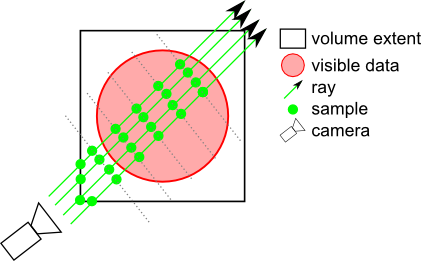
DATA_ALIGNED: Samples are located on planes perpendicular to one axis of the volume.

BOUNDARY_ALIGNED: Samples are located on shells aligned with the volume's internal "boundary". Each ray begins sampling at the first intersected voxel that has an alpha value >
opacityThreshold. This technique greatly decreases "slicing" artifacts even with a relatively small number of slices. It is strongly recommended to enable this mode when usingSoVolumeRenderingQuality.ambientOcclusion.
SMOOTH_BOUNDARY_ALIGNED: Similar to BOUNDARY_ALIGNED but uses a cubic interpolation to compute the boundary, giving smoother results when using
SoVolumeRenderingQuality.deferredLighting.NOTE: If an
SoVolumeGrouporSoProjectionnode applies to this node, the field is ignored and VIEW_ALIGNED is used.- Since:
- Open Inventor 9.1
-
opacityThreshold
public final SoSFFloat opacityThreshold
Specifies a threshold opacity (alpha) value that defines voxels considered to be "solid" (non-transparent). Many volume data sets are composed of objects of interest floating in an approximately transparent "fog", depending on opacity values in the transfer function. Several effects like BOUNDARY_ALIGNED sampling, ambientOcclusion and deferredLighting need to locate the boundary between solid objects and ambient fog. This field defines a threshold in the range [0, 1]. Voxels are considered solid if their alpha value is greater than opacityThreshold.A value of 0.0 generally works well with a transfer function containing "binary" opacity (a transfer function with only fully transparent or fully opaque colors). If this is not the case, you should set this value according to your visualization parameters. Generally between 0.1 and 0.5.
Default is 0.1, Ignore low visibility voxels.
- Since:
- Open Inventor 9.3
-
lighting
@Deprecated public final SoSFBool lighting
Deprecated.As of Open Inventor 8500. Use SoVolumeRenderingQuality.lighting field instead.Indicates if lighting is required. Default is false.
NOTE: Better performance for lighting can be obtained using theSoVolumeRenderingQualitynode. UsingSoVolumeRenderingQuality, lighting is determined by the first light in the scene graph (similar to other geometry) and the lighting computation is done on the GPU (thereforeSoVolumeRenderingQualityrequires programmable shaders).Using the
lightingfield, lighting is determined by thelightDirectionfield and the lighting computation is done on the CPU. This requires RGBA textures to be loaded on the GPU which uses more texture memory and requires more time to modify the transfer function (color map) because textures must be reloaded. Note that activating or deactivating lighting will also normally force the textures to be recreated, which may be slow.NOTE: Only set the lighting field to true in
SoVolumeRenderingQualityorSoVolumeRender. Do not set bothlightingfields to true.Warning Deprecated since Open Inventor 8500. Use
SoVolumeRenderingQuality.lightingfield instead.
-
lightDirection
@Deprecated public final SoSFVec3f lightDirection
Deprecated.As of Open Inventor 8500. Use SoVolumeRenderingQuality.lighting field instead.Light direction (relative to the volume). The default is (-1,-1,-1). Only affects CPU computed lighting (i.e. when thelightingfield is true).Warning Deprecated since Open Inventor 8500. Use
SoVolumeRenderingQuality.lightingfield instead.
-
lightIntensity
@Deprecated public final SoSFFloat lightIntensity
Deprecated.As of Open Inventor 8500. Use SoVolumeRenderingQuality.lighting field instead.Light intensity in the range [0-1]. The default is 1. Only affects CPU computed lighting (i.e. when thelightingfield is true).Warning Deprecated since Open Inventor 8500. Use
SoVolumeRenderingQuality.lightingfield instead.
-
viewAlignedSlices
@Deprecated public final SoSFBool viewAlignedSlices
Deprecated.As of Open Inventor 9100. Use samplingAlignment field instead.Indicates if samples should be computed in a view-aligned manner. Default is true.NOTE: If an
SoVolumeIsosurface,SoVolumeRenderingQualityorSoProjectionnode applies to this node, this field is ignored and view-aligned samples are used.Warning Deprecated since Open Inventor 9100. Use samplingAlignment field instead.
-
-
Method Detail
-
setRenderProgress
public void setRenderProgress(SoProgressIndicator ps)
Set an application definedSoProgressIndicatorobject which will raise an event before and after the volume rendering task, before and after each subtask (in this case: Texture creation and Geometry creation) and after each step in the subtasks which represents in most cases individual tiles of data.SoProgressIndicator.onBeginTask/SoProgressIndicator.onEndTaskwill be raised only one time per frame : "Rendering".SoProgressIndicator.onBeginSubTask/SoProgressIndicator.onEndSubTaskwill be raised 2 times per frame : "Loading Texture" and "Create Geometry".SoProgressIndicator.onEndStepwill be raised several times per subtask.
Track loading progression with
SoProgressIndicator.onEndStepevent of SubTask "Loading Texture":- NumSteps represents here the number of tiles to load to reach the "stable rendering state".
- NumStepsDone represents here the number of tiles currently loaded since the last NumSteps reset.
- The two numbers are reseted when the viewer is moving the camera.
Limitations :
- if MaxMainMemory (CPU Mem) is lower than MaxTexMemory (GPU mem) the number of steps to reach the "stable rendering state" will be bigger than expected (the progress bar will stop without reaching the end).
- if screen resolution culling is activated (see
SoLDMGlobalResourceParameters.setScreenResolutionCulling) the number of steps to reach the "stable rendering state" might be lower than expected (progress bar reaches the end but loading might continue).
If set to NULL no events will be raised. Default is NULL.
- Since:
- Open Inventor 9.9
-